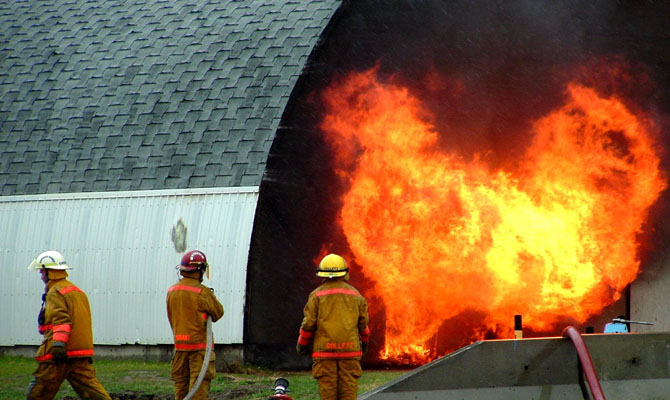By Craig Remsburg – Craig Remsburg’s first career was an industrial fire chief. He worked for Boeing Corporation and has served as a fire protection consultant and Director of Human Resources for Telgian Corporation. Along with human resources, Craig developed and continues to manage training programs for industrial fire departments.
In Kentucky, where the Bourbon whiskey industry generates more than $125 million in tax revenue each year, knowing the specific properties of whiskey-related fires is critical to preserving people, product, and property. Earlier this year, 25 volunteer firefighters gathered at a fire station in Lexington, Ky., to receive training specific to fighting whiskey-related fires. But specialized training is not only important in treating alcohol-based fires. Organizations dealing with unique hazards of all kinds should take steps to ensure they are protected in case of an emergency.
Assuming the Responsibility of Fire Protection
Any organization selling or manufacturing goods assumes a certain level of risk, and it is their responsibility to protect against it. Similarly, fire departments assume the responsibility of protecting people in emergency situations. So, when it comes to properly preparing for unusual or atypical fire risk, who should take the lead?
It is not uncommon for organizations to lead this charge, taking time to ensure the corresponding firefighting community serving the area knows the specific hazards present at their facility. In the case of the whiskey manufacturer and distributor in Kentucky, the company knew it had a specific safety hazard to address that went beyond typical fire training protocols. The organization brought in third-party experts to assess the risk and conduct a special training with the local fire department about ways to treat fire hazards at the facility.
Over the past decade fire departments have progressively increased the amount of specialized trainings, certifications, and programs offered to increase firefighting proficiencies. The local volunteer fire department in Kentucky reacted positively to the training offered by the organization and encouraging full department participation and taking the initiative to learn new skills. While the training was specific to fighting alcohol-related fires, the skills acquired have broader applications that can be used to protect the public in other emergency situations.
Managing Risks Proactively
If a facility has unique safety challenges that pose a high risk of damage to people, product, or property, the only way to minimize devastation in an emergency situation is to prepare in advance. Often insurance companies require a proof of risk management protocols before agreeing to insure an organization. Thinking ahead and having the proper safety systems in place to minimize risk in an emergency, such as sprinkler systems, fire alarms, extinguishers, and specially-trained fire brigades, can help mitigate insurance costs.
According to the National Fire Protection Association, there were 1.3 million fires reported in the United States in 2015, resulting in 3,280 civilian deaths, 15,700 civilian injuries, and $14.3 billion in property damage. When looking at the 25 largest fire losses in U.S. history to date, several organizational fires occurring at high-risk facilities stand out. These catastrophic events cost many lives and resulted in billions of dollars in property damage. Knowing a disaster can have detrimental effects personally and financially should be a driving force for organizations to take the lead in securing their facilities against high-risk hazards.
Calling in the Experts
Third-party experts can help organizations and local fire departments develop specialized skills to help in high-risk situations. Organizations with unique hazards in their facilities do not typically have the proper experience or qualifications, either internally or through the local public resources, to handle it. Bringing in an outside expert to train the proper responding authorities on how to develop and execute a safety program from the beginning stages can be invaluable when an emergency hits.
Fire training investments can be made either inside or outside the organization – or both – depending on the nature of the risks involved and the available resources. In Kentucky, the organization did not have adequate in-house resources to respond to a fire internally, so the local volunteer fire department worked hand-in-hand with the whiskey distributor to acquire and deploy a new fire hazard protection program for the facility. At an alcohol manufacturing facility in Mexico, owned by the same parent company, third-party experts trained an in-house fire brigade to ensure they were prepared to respond to the significant fire and safety risks presented by alcohol-based fires.
Stepping up to the Challenge
The last thing any organization wants to contemplate is experiencing a disaster, but those that take steps to ensure proper fire and safety protocols in the event of an emergency save not only on the front end, through insurance rate negotiations, but in the long run, should they need to deploy a disaster plan. Insurance risk adjusters will often ask, “What are you doing to protect the people, products, and structure of your facility?” If an organization’s answer is not, “everything we can,” then they are not doing enough.


